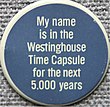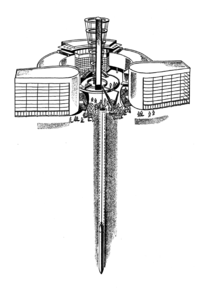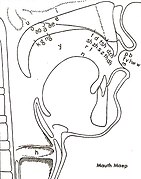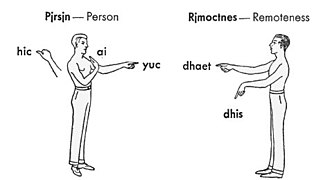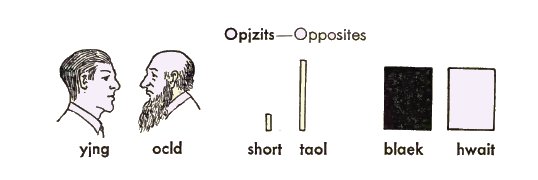
Flushing Meadows–Corona Park, often referred to as Flushing Meadows Park, or simply Flushing Meadows, is a public park in the northern part of Queens in New York City, New York, U.S. It is bounded by I-678 on the east, Grand Central Parkway on the west, Flushing Bay on the north, and Union Turnpike on the south. Flushing Meadows–Corona Park is the fourth-largest public park in New York City, with a total area of 897 acres (363 ha).

The 1964–1965 New York World's Fair was a world's fair that held over 140 pavilions and 110 restaurants representing 80 nations, 24 U.S. states, and over 45 corporations with the goal and the final result of building exhibits or attractions at Flushing Meadows–Corona Park in Queens, New York City. The immense fair covered 646 acres (2.61 km2) on half the park, with numerous pools or fountains, and an amusement park with rides near the lake. However, the fair did not receive official support or approval from the Bureau of International Expositions (BIE).

The Unisphere is a spherical stainless steel representation of the Earth in Flushing Meadows–Corona Park in the borough of Queens in New York City, New York, United States. The globe was designed by Gilmore D. Clarke as part of his plan for the 1964 New York World's Fair. Commissioned to celebrate the beginning of the space age, the Unisphere was conceived and constructed as the theme symbol of the World's Fair. The theme of the World's Fair was "Peace Through Understanding", and the Unisphere represented the theme of global interdependence, being dedicated to "Man's Achievements on a Shrinking Globe in an Expanding Universe".

The 1939–1940 New York World's Fair was a world's fair held at Flushing Meadows–Corona Park in Queens, New York City, United States. It was the second-most expensive American world's fair of all time, exceeded only by St. Louis's Louisiana Purchase Exposition of 1904. Many countries around the world participated in it, and over 44 million people attended its exhibits in two seasons. It was the first exposition to be based on the future, with an opening slogan of "Dawn of a New Day", and it allowed all visitors to take a look at "the world of tomorrow".

The Westinghouse Electric Corporation was an American manufacturing company founded in 1886 by George Westinghouse. It was originally named "Westinghouse Electric & Manufacturing Company" and was renamed "Westinghouse Electric Corporation" in 1945. The company acquired the CBS television network in 1995 and was renamed "CBS Corporation" until being acquired by Viacom in 1999, a merger completed in April 2000. The CBS Corporation name was later reused for one of the two companies resulting from the split of Viacom in 2005.
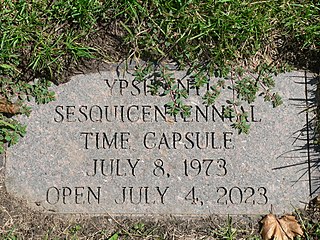
A time capsule is a historic cache of goods or information, usually intended as a deliberate method of communication with future people, and to help future archaeologists, anthropologists, or historians. The preservation of holy relics dates back for millennia, but the practice of preparing and preserving a collection of everyday artifacts and messages to the future appears to be a more recent practice. Time capsules are sometimes created and buried during celebrations such as a world's fair, a cornerstone laying for a building, or at other ceremonies.
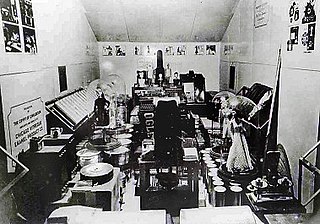
The Crypt of Civilization is an impenetrable airtight chamber, built between 1937 and 1940, at the Oglethorpe University in Brookhaven, Georgia. The 2,000-cubic-foot (57 m3) repository is meant not to be opened before 8113 AD. It contains numerous artifacts and sound recordings that illustrate civilization and human development to the 20th century. Classic literature and religious texts were also deposited, as well as items showing the extent of scientific progress to 1939.

The Mets–Willets Point station is a rapid transit station on the IRT Flushing Line of the New York City Subway. Located near the Citi Field baseball stadium, it is served by the 7 train at all times and by the express <7> train rush hours in the peak direction or after sporting events. This station is located near Flushing Meadows–Corona Park in Willets Point, Queens, on Roosevelt Avenue between 114th and 126th Streets.
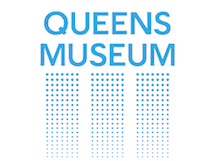
The Queens Museum, formerly the Queens Museum of Art, is an art museum and educational center located in Flushing Meadows–Corona Park in the borough of Queens in New York City, United States. The museum was founded in 1972, and has among its permanent exhibitions, the Panorama of the City of New York, a room-sized scale model of the five boroughs originally built for the 1964 New York World's Fair, and repeatedly updated since then. It also has a large archive of artifacts from both the 1939 and 1964 World's Fairs, a selection of which is on display.

The IND World's Fair Line, officially the World's Fair Railroad, was a temporary branch of the Independent Subway System (IND) serving the 1939 New York World's Fair in Queens, New York City. It split from the IND Queens Boulevard Line at an existing flying junction east of Forest Hills–71st Avenue station, ran through the Jamaica Yard and then ran northeast and north through Flushing Meadows–Corona Park, roughly along the current path of the Van Wyck Expressway. The line continued along a wooden trestle to the World's Fair Railroad Station, located slightly south of Horace Harding Boulevard. The World's Fair station, the only one on the line, consisted of two tracks and three platforms.

Queens Botanical Garden is a botanical garden located at 43-50 Main Street in Flushing, Queens, New York City. The 39-acre (16 ha) site features rose, bee, herb, wedding, and perennial gardens; an arboretum; an art gallery; and a LEED-certified Visitor & Administration Building. Queens Botanical Garden is located on property owned by the City of New York, and is funded from several public and private sources. It is operated by Queens Botanical Garden Society, Inc.

Thornwell Jacobs was a professor, historian, author, fundraiser, university founder, and Presbyterian minister. He earned degrees from Presbyterian College in South Carolina and the Princeton Theological Seminary in New Jersey. He wrote The Law of White Circle, a novel about mulattos set during the Atlanta race massacre of 1906.

The R15 was a New York City Subway car model built by the American Car and Foundry Company in 1950 for the IRT A Division. A total of 100 cars were built, arranged as single units. Two versions were manufactured: Westinghouse (WH)-powered cars and General Electric (GE)-powered cars.
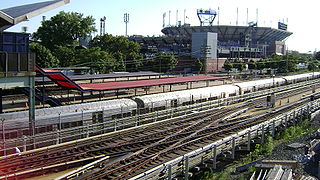
Mets–Willets Point is a station on the Long Island Rail Road's Port Washington Branch in Flushing Meadows–Corona Park, Queens, New York City. Prior to 2021, the station would normally be open only during New York Mets home games, the U.S. Open tennis tournament, major events, and emergencies. The station has been served full-time since 2023.

The Flushing River, also known as Flushing Creek, is a waterway that flows northward through the borough of Queens in New York City, mostly within Flushing Meadows–Corona Park, emptying into the Flushing Bay and the East River. The river runs through a valley that may have been a larger riverbed before the last Ice Age, and it divides Queens into western and eastern halves. Until the 20th century, the Flushing Creek was fed by three tributaries: Mill Creek and Kissena Creek on the eastern bank, and Horse Brook on the western bank.
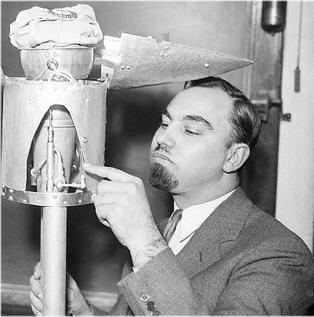
George Edward Pendray was an American public relations counselor, author, foundation executive, and founder of the American Interplanetary Society.
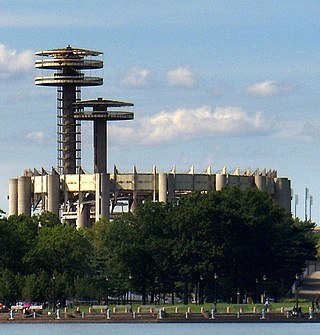
The New York State Pavilion is a historic world's fair pavilion at Flushing Meadows–Corona Park in Flushing, Queens, New York, United States. It was designed in 1962 for the 1964 New York World's Fair by architects Philip Johnson and Richard Foster, with structural engineer Lev Zetlin.
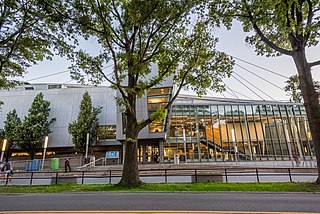
The Flushing Meadows Corona Park Natatorium and Ice Rink, also known as the Flushing Meadows Corona Park Pool and Rink or Flushing Meadows Natatorium, is a 110,000-square-foot (10,000 m2) facility in Flushing Meadows-Corona Park, Queens, New York City, with an Olympic-sized pool and an NHL-standard rink. Built in 2008, the $66.3 million project is the first indoor public pool to open in New York City in four decades. Initially, the building was intended to serve as the venue for water polo events during the 2012 Summer Olympics, but when the city's bid was lost to London, the New York City Department of Parks and Recreation proceeded to build the pool anyway. The result is an innovative building with 130-foot-high twin masts and a swooping roof form. The masts are an architectural feature extending up into the Queens skyline as well as the structural supports for the cable-stayed roof. This design provides the clear spans necessary to house an Olympic swimming pool along with an ice skating rink.

Kissena Creek is a buried stream located in the neighborhoods of Flushing, Fresh Meadows, Hillcrest, and Kew Gardens Hills in the New York City borough of Queens. Kissena Creek originates in a now-filled swamp within Kew Gardens Hills and Pomonok in central Queens, flowing east to Hillcrest. The creek then travels mostly north and west, largely flowing beneath Kissena Park Golf Course, Kissena Park, Kissena Corridor Park, and Queens Botanical Garden, before merging with the Flushing River in Flushing Meadows–Corona Park.

The Q58 and Q58 Limited are bus routes that constitute a public transit line operating primarily in Queens, New York City, with its southern terminal on the border with Brooklyn. The Q58 is operated by the MTA New York City Transit Authority. Its precursor was a streetcar line that began operation in November 1899. and was known variously as the Flushing–Ridgewood Line, the Corona Avenue Line, and the Fresh Pond Road Line. The route became a bus line in 1949.



